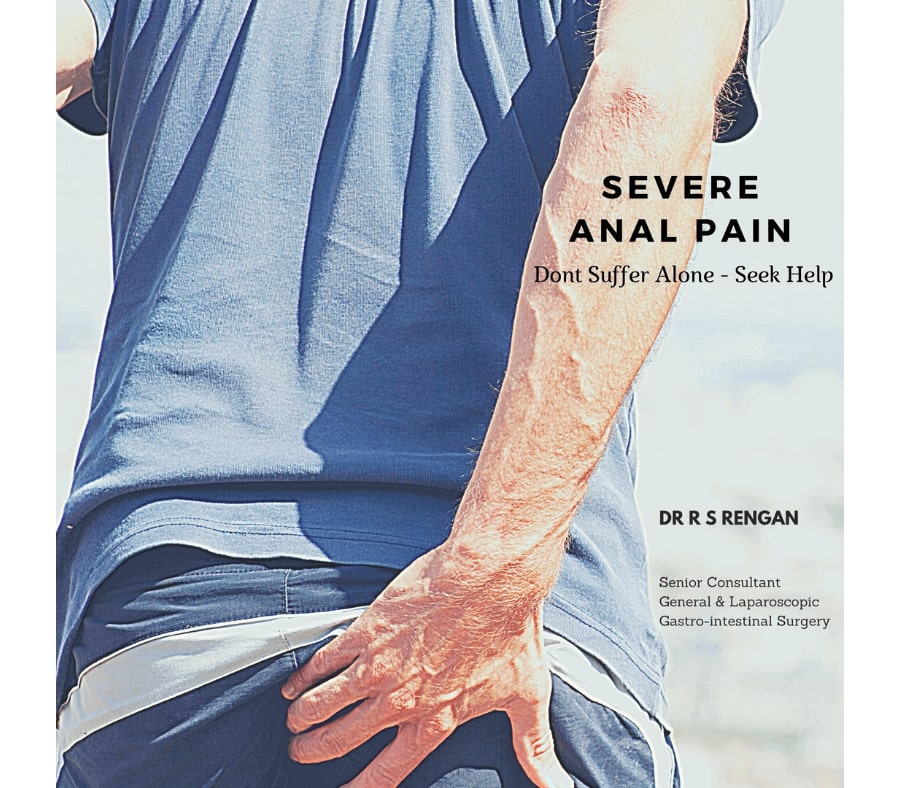
ANAL PAIN AND CAUSES:
Pain around the bottom or in the anal opening can be a cause of distress and discomfort to many. It is not uncommon to feel frustrated, helpless, or embarrassed by these problems. The good news is that most of these issues are NOT very dangerous. In this series of blogs, We will break down and explain some of the causes of anal pain, why they happen, and what the solutions are to these issues. Dr. Rengan is one of the senior-most surgeons in the country who has been dealing with piles/ fissure/ fistula and other causes of anal pain
First, let us look at some of the common causes:
ANAL FISSURE:
An anal fissure can simply be described as an anal tear. Sometimes, while passing a hard or large stool, it can tear the delicate tissue in or at the base of the anal passage. Since the tissue there is very sensitive, filled with a lot of sensory nerve connections, it can be the cause of immense pain.
Many people describe the pain as a burning or tearing pain that begins while passing stool, lasts for quite a while, and even after dulling, stays a throbbing or dull pain for hours. Some people might find that they are unable to sit comfortably after because of the dull pain. Apart from the pain, there might even be some bleeding, and patients might notice blood in the toilet bowl or on wiping.
While anal fissures are extremely painful, they do resolve by themselves in a couple of weeks. In order to heal, stools must be kept soft so that further injury or retearing does not occur. This can be accomplished by drinking plenty of water, eating a lot of fiber, and not holding stool in (go to the toilet when you feel the urge!). Avoid dehydrants like alcohol and coffee in excess.
If you find that your anal fissure has not improved or resolved despite taking these measures for more than 2 weeks, please do visit a doctor. You might need some medication to promote healing, or may need an examination to rule out other causes.
HEMORRHOIDS/PILES:
Piles, also called hemorrhoids, is a condition in which the veins in the back passage get swollen and cause discomfort, pain, itching or bleeding while passing stool. There are two types: internal and external hemorrhoids.
Internal hemorrhoids are usually painless, but that can make the bleeding seem more alarming. External hemorrhoids can be painful by causing stress and erosion on the surrounding skin. Sometimes a blood clot forms in an external hemorrhoid. If the clots are large, they can cause pain while walking, sitting, or having a bowel movement.
The mass may appear suddenly and get worse in pain during the first 48 hours. The pain generally lessens over the next few days. Home remedies include warm tub baths (sitz baths), pain medications, and stool softeners. Most experts recommend that the blood clots be removed surgically. This short surgery can be done in the surgeons office or at the hospital under local anesthesia.
ANAL FISTULA/ABSCESS:
Small glands just inside the anus are part of normal anatomy. If the glands in the anus become clogged, this may result in an infection. When the infection is serious, this often leads to an abscess. Sometimes, the infection can create a tract through the canal wall and out through the skin. This is called a fistula. Most often, fistulas are associated with abscesses but they can sometimes occur by themselves.
Abscesses can be treated with antibiotics or simple drainage if detected early. However, fistulas need surgery.
A rare but dangerous cause of anal pain or bleeding is colorectal cancer. Since symptoms can be similar to those caused by hemorrhoids, it is imperative that a doctor checks the issue and performs a colonoscopy in these cases.
There is an unspecified cause of Anal pain called Proctalgia Fugax – which is severe unexplained anal pain. It can be very severe at times.
Do consult us at the Home of Healing Surgical Center if you experience anal pain. It is imperative that certain conditions be caught early for optimal treatment. Our center has a long and illustrious history of treating anorectal disorders and is, therefore, best suited to your needs.
